A high-quality winch is a must-have for any truck owner interested in using the off-road and utilitarian capabilities of their trucks. And while it is always preferable to not need a winch at all, sometimes things don’t always go exactly as planned and having a reliable winch can be a lifeline that makes the difference between a minor inconvenience and a day-ruining debacle. The bottom line is this: having a winch is essential, and there’s a lot to know about them before you decide to buy.
What do you need to know about winches? There are several different things to know about winches, with the most important items being:
- Cable type
- Capacity
- How it’s powered
- How to install a winch
- Winch maintenance
Winches are complex and surprisingly intricate pieces of equipment, and having a proper understanding of all the information is an essential step in responsibly and correctly owning and operating one. So, with a lot of information to cover, let’s dive right in.
Different Types of Winches
There are many different types of winches available for trucks on today’s market, but they all serve the same purpose: to pull things (usually your vehicle) out of places where you don’t want them to be. And while all winches do mostly serve the same purpose (commonly referred to as self-recovery), they can go about doing so in a couple of different ways, with varying cable types, methods of being powered, capacities, and more.
Winch Capacity
The capacity of a winch is perhaps the most important thing to consider when buying one for your truck. Today’s market is flooded with hundreds of different offerings, with capacities ranging from as low as 1,000lbs to as high as 20,000lbs.
The smaller, lower-capacity winches are typically reserved for ATVs or other small off-road vehicles. In contrast, the higher capacity winches are preferred by truck owners with heavy-duty trucks whose weight vastly exceeds that of the more common light-duty trucks. For example, a Chevy Silverado 1500 Single Cab is not going to need the high capacity winch that a Silverado 2500 Crew Cab Duramax will need.
Determining what capacity winch is best for your truck is a process that is still under debate, but Pickup Trucks recommends picking a winch whose capacity is at least double the weight of your vehicle. Some will argue that this isn’t necessary, but winches are effectively a means of insurance when off-roading, and we all know that cheap insurance never works out the way that we want it to.

The reason that we recommend choosing a winch with a capacity double that of the truck is simple: stronger is better when it comes to winches. When a vehicle is stuck and in need of a winch, you’ll want something that you know can do the job quickly and effectively.
It’s not just a matter of having a bit of overkill, though. When trucks are stuck, there is often significantly more drag on the tires than there usually would be, effectively increasing the weight of the vehicle.
So, if you have a winch whose capacity is just equal to the weight of your truck, it will not work if you’re badly stuck and in need of saving. For this reason, it’s best to go for a winch that has a capacity that is double the weight of your truck.
Cable Type
There are two primary types of cables used on winches today: steel cable lines and synthetic cable lines. Steel cable lines are, of course, made from steel, while synthetic cable lines are made from polyethylene material. There a number of pros and cons to each type of cable, so let’s break them down in a bit more detail.
Steel Cables
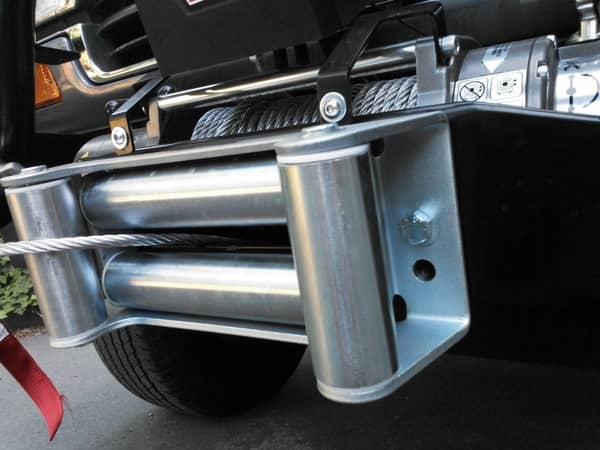
Steel cables are still very commonly used in winches, and the reason is simple: they work! Steel cables are strong and durable and have therefore become a go-to for winch manufacturers as a function of their durability.
Winches are often used in environments that are less than ideal for maintaining delicate materials, so having something as durable as steel can be a significant bonus for winch-owners. If the cable is commonly subject to abrasions from rocks and trees and being covered in mud, water, and other grime, a steel cable will be able to stand up to this abuse.
However, steel cables are not without a few downsides. For one, they can degrade over a long period, and start to fray. Once this begins to happen, using the cable becomes extremely dangerous. Steel cables can hold a lot of energy, especially when under tension as they are when in use; if one snaps, it can be incredibly dangerous. Therefore, you should absolutely never use a steel cable that is showing any significant signs of wear.
Here’s what you should take away about steel cables:
- Pros: Strong, durable, can withstand heavy use
- Cons: Degrade over time, very dangerous if they fail
Synthetic Cable
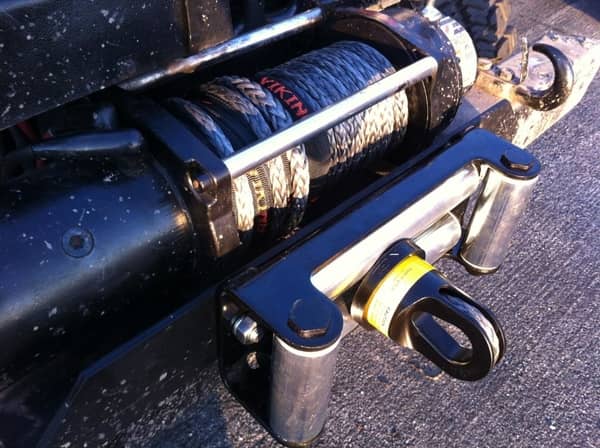
So, while steel cables are still standard, and effective, synthetic ones have been on the rise as a replacement, as a result of how dangerous steel cables can be if they do fail while in use. Synthetic cables are far less harmful when they collapse under tension, though they are actually stronger than steel cables, as much as 15 times more, according to Ronstan Industrial.
So, if synthetic cables are stronger, and aren’t potentially fatal when they fail, why would anyone use steel? That’s a fantastic question, and the answer is simple: synthetic cables are not nearly as durable as steel cables.
While steel cables are more than capable of being rubbed on rocks and through the dirt and mud, synthetic ones are far less apt to handle the common abuse that a winch cable is likely to see off-road. Because of this, some owners still do prefer steel cables, but that sentiment is slowly fading in favor of synthetic cables.
Additionally, it’s important to know that most major off-roading events now require that you use a synthetic cable as opposed to a steel one, simply because they are a far safer option. Steel cables can cause serious injury if they fail under tension, and this is something that should be avoided at all costs. The best way to do that is to use a synthetic cable.
So, here’s our takeaway on synthetic cables:
- Pros: Lightweight, stronger than steel, not as dangerous as steel if it fails
- Cons: Not as durable, will wear more quickly with continued use
In comparing steel versus synthetic cables, it is, of course, best to weigh each pro and con in relation to how you plan to use your winch. If you see yourself continually running the winch around rocks and edges, and need something to handle that abuse, steel may be your best option. However, we do generally recommend synthetic for most applications, as it is far, far safer, which should always be your number one priority.
Electric vs. Hydraulic
The final primary trait that separates different types of winches is the way in which it is powered. There are two different ways to power a winch: electronically or hydraulically. Electric winches are far, far more common than hydraulic winches, but that’s not to say that there isn’t a case to be made for hydraulic winches.
Before we talk about the pros and cons of each different type, though, let’s go over how each works.
Electric Winches
An electric winch works by connecting the winch’s motor to the battery of the truck and drawing power from its electrical system. This is a simple setup; however, you need to make sure that your vehicle has enough battery power, and that you don’t purchase a winch that may exceed your truck’s electrical system’s capacity.
This can be done by checking the winch’s power rating, usually a measure of the amperage required to operate it, and then cross-checking that with your truck’s electrical system output, also typically expressed as amperage. If your truck’s electrical system has an amperage output higher than the amperage draw of the winch, you’re good to go.
Hydraulic Winches
Hydraulic winches, on the other hand, are a little bit more complicated than their electric counterparts. These types of winches are powered mechanically, usually by being connected to the truck’s power-steering pump.
This requires a much more involved installation process; however, there are truck-owners that absolutely swear by hydraulic winches, as they are incredibly reliable, and you don’t have to worry about your truck having enough juice to power the winch. That being said, some auto-manufacturers are switching to electric power steering, which renders the use of a hydraulic winch all but impossible.
To sum up the consideration that should be given to choosing an electric versus hydraulic winch: it really does boil down to personal preference.
Unlike the choice of steel versus a synthetic cable, there is no safety concern or difference between the two. It just depends on how much time (or money on labor, if you use a shop) you want to spend installing it, and how important reliability, simplicity, and ease of use is for your specific application.
Winch Pricing
Now that we’ve spent some time discussing the various things to consider when looking at buying a winch, we can start to look at what you can expect to pay when you purchase a winch for your truck.
As should be evidenced by the information discussed above, choosing a winch is entirely dependent on your preferences and needs. So, rather than looking at specific winch recommendations, it will be more useful to outline three distinct price brackets and letting you find the right winch that suits your needs within each price category.
Cheap Winches: <$400
There are a number of different options for people that just want an absolute last-resort type of winch. This price bracket is suitable for those who don’t need the cream of the crop and only anticipate using their winch rarely, if ever, but want it for peace of mind.
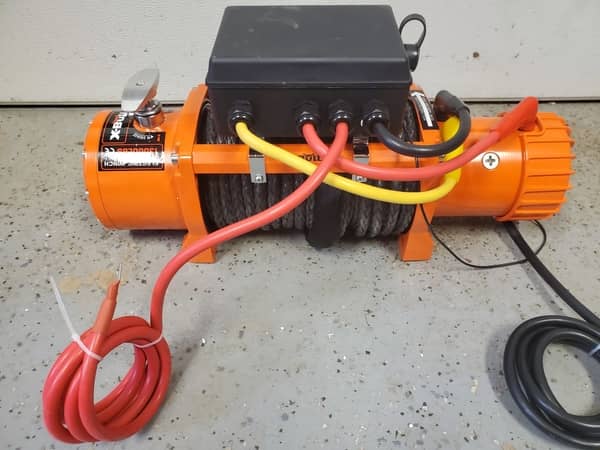
Winches in this price bracket are typically less powerful, and unable to handle very large capacities. Additionally, you’re unlikely to find a winch in this range that is made of top materials, with their gears, reels, and drums being constructed of less durable and weaker materials than what is more commonly found on high-end winches.
However, a cheap winch can be perfectly suitable for lighter-weight vehicles, and for owners that don’t anticipate using their winch very frequently. However, if you have a full-sized truck, or plan to do lots of off-roading where your winch might see some frequent use, it is best to look at the next two categories.
A great example of winch that falls into this category can be found here.
Middle of the Road Winches: $400-$1,000
This is the pricing range wherein you can expect to start finding some higher quality winches. Winches in this category are more likely to come standard with more top quality materials, and we can begin to see winches with capacities that are suitable for full-sized and larger trucks.
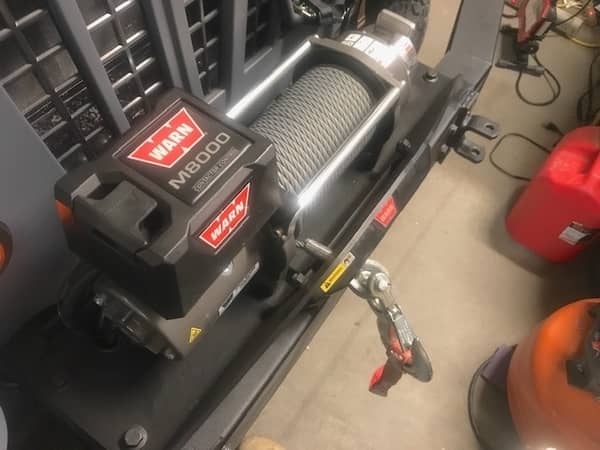
Additionally, winches in this category are more often going to be manufactured by name brands, which can help to reassure buyers that they’re actually getting a high-quality piece of equipment.
Features that are commonplace in this price range include more durable gear materials and robust construction. Additionally, winches in this category are going to be rated to withstand more abuse, and are water and dust resistant.
Generally, this is the price range that we would recommend most winch buyers look into first, to assess whether these winches will be suitable (which they likely will be), or if you need to move up to the absolute top-dog winches available on the market.
A great example of a winch that falls into this price range can be found here.
Expensive Winches: $1,000+
Winches that cost over $1,000 are the absolute top of the line models, with extremely durable construction, near-complete water-proofing, and high-quality cables. Additionally, winches in this category are likely to have very high capacities, which can be a necessity for people with larger trucks that may warrant the purchase of a high capacity winch.
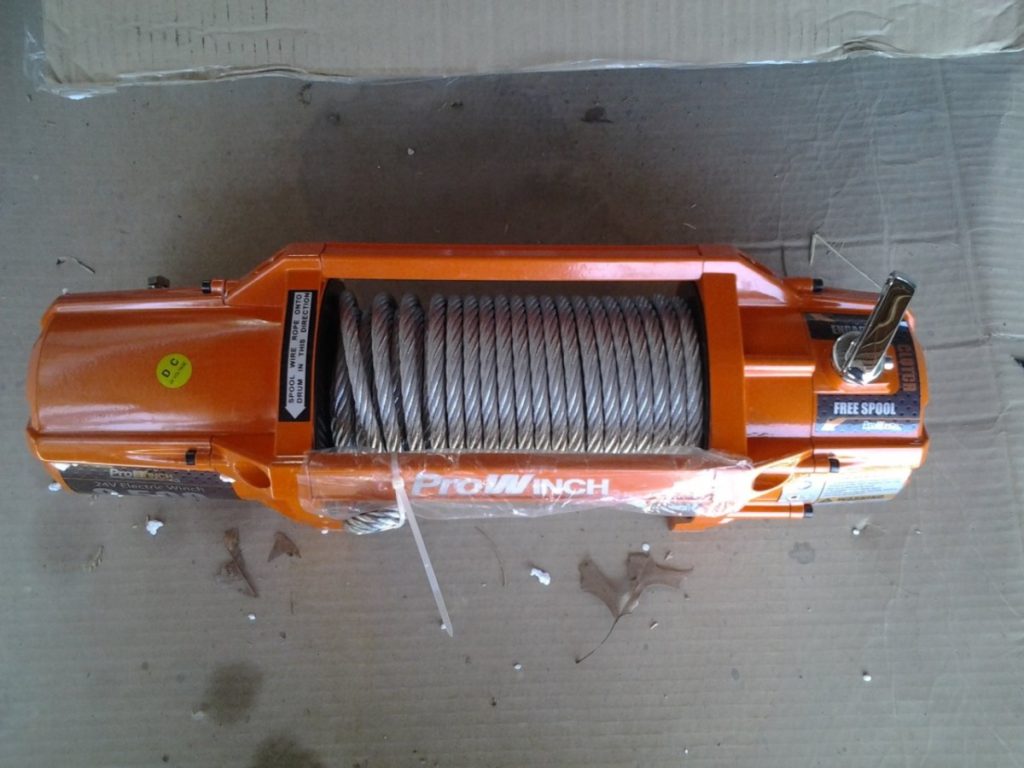
With the praises of these top-dog winches being sung, though, it is essential to know that very few people actually need to spend this much on a winch. You’re likely to get all you need and more from a sub-$1,000 winch; however, if you want to know that you have the absolute best hanging off of your bumper (or if you have a truck that needs it), the $1,000+ price bracket is where you should be looking.
An example of a winch that meets this description can be found here.
Installing a Winch
Now that you know what to look for when buying your winch, it’s time to learn about what goes into installing a winch. Installing a winch is not terribly difficult, but there are some things that are important to know before you do it. So, let’s go over what a typical winch installation entails.
- Determine if the winch will fit your stock bumper. The first step in installing a winch is to determine whether or not it will be compatible with your truck’s stock bumper. Most winches will be compatible with a stock bumper with some modification, and the easiest way to know is to check with the winch manufacturer. Most of the time, a winch can be mounted to a stock bumper; however, an aftermarket bumper is sometimes necessary. A good aftermarket bumper will almost always come with a dedicated spot to attach a winch.
- Unbox your winch. Now that you’ve got the bumper situation sorted, you can start unboxing your winch. Most winches will come with everything that you need to install them properly, and this includes a few different parts: the winch itself, mounting hardware, electrical wiring, a hook, and some winch line.
- Attach the line to the drum. Some will advocate for leaving this step for last, but it can be more challenging to attach the line to the drum once the winch is installed, which is why we recommend doing so first. While some manufacturers will ship the winch with the line already on the drum, many do not, which means that you have to do it yourself. This is generally a fairly easy process, with the winch line attaching via either a bolt to the drum or a loop system. Determine which method your winch uses, and install accordingly. If your winch uses a bolt system to attach the line to the drum, simply bolt up and move on. If it uses a loop system, however, you may want to try using a thin wire or cord to help you fish the line through the loop.
- Attach the winch to the bumper. Your winch is now ready to be installed onto your truck, so the next step is getting your mounting hardware together and bolting it up. Make sure that your mounting hardware is aligned correctly to the surface upon which the winch will be mounted, and have a friend hold the winch in its mounting place, while you secure the winch to the bumper using the supplied hardware. Additionally, make sure that your winch’s mounting plate is in place correctly before securing anything entirely. Once you have everything lined up, torque all of your bolts down, and make sure that your winch is secure.
- Connect the winch to the battery. Now that your winch is mounted, it’s time to connect it to the battery. This is probably the easiest part of the installation, just be sure that you’re running your wires as best as you can. It may be wise to use some zip ties to secure all of the wirings in place, or perhaps some electrical tape. Once you determine how you’d like to run your wires, go ahead and run them to the battery.
- Attach the winch hook. Lastly, a winch is not much use without a hook, so don’t forget to put yours on once everything is mounted and wired. After your winch hook is installed, you’re ready to go. Go ahead and give your new winch a few turns to make sure everything is working correctly, and rejoice in your latest successful truck modification!
Winch Maintenance
Now that your winch is installed, it’s time to get an idea of what it takes to keep a winch working properly for as long as possible. Winches are intricate pieces of equipment with lots of moving mechanical parts, and of course, some electric components as well. Because of their complexity, they do require maintenance in order to maximize both their effectiveness as well as their longevity. Here are some basic tips to keep your winch working as well as possible for as long as possible.
Keep it Clean
The most crucial piece of winch maintenance is luckily the easiest, as well: keep your winch clean. Winches are unique to other equally complex mechanical parts in that they are mounted to the exterior of the vehicle, and are typically front and center on the front bumper. What this means is that winches are subject to get extremely dirty every time the truck goes off-road, often coming back from a trip caked in mud and dirt.
While getting your truck dirty is part of the off-road experience, it’s not part of the responsible winch-owner experience. If left covered in mud, dirt, and other grime, the winch will degrade much more quickly, and this mud can begin to seep into places where it’s presence could mean trouble for longevity and effectiveness.
So, if you intend to keep your winch working for as long as possible, you need to clean it thoroughly after every single outing, even if it wasn’t used at all.
The best way to clean your winch is with a simple hose and soap wash down, making sure to get every nook and cranny with a relatively high-pressure jet of water. Additionally, don’t be afraid to get in with a wash mitt to remove any debris that is stuck around the cable or reel, or is simply caked onto the outside of the winch.
Additionally, if your winch was used during your latest off-road outing, it’s likely that the cable got quite dirty as well. For this reason, it’s essential to unreel the cable and to get that as clean as you can with soap and water; this will prevent any premature degradation as a result of that mud being left on there to eat away at the cable material.
As a note, Warn, a popular winch manufacturer, cites synthetic lines as requiring more careful cleaning than traditional steel, something synthetic line users need to keep in mind.
Invest in a Winch Cover
While it isn’t necessary to clean your winch after a drive to the store like it is after a bog through the mud, it is still a good idea to keep an eye out for your winch during day-to-day road driving. The best way to do this is to look into purchasing a winch cover. Winch covers are relatively inexpensive and are a fantastic way to keep your winch in good shape for as long as possible.
Winch covers typically fit right over the top of the winch and can be removed very easily when the winch does need to be used. They can protect the winch from typical road grime, as well as provide some protection against road salt in the more northern states.
However, while a winch cover is an excellent investment, it is not a substitute for properly cleaning your winch after going off-road. Just because your winch was covered doesn’t mean that it didn’t get dirty. Even if you have your winch covered up, it’s best to remove the cover after off-roading to make sure that nothing got underneath it.
Keep Your Cable Neat
One of the worst habits that a winch owner can get into is reeling in their cable sloppily and without regard to maintaining a nice, neat bundle on the drum. The cable should always be reeled back onto the drum in neat rows, with no criss-crossing or unusual kinks or bends. If this is ignored, it can be more difficult to unwind the cable next time or even make it impossible if you manage to reel in the cable very un-neatly. To avoid this problem, be careful, and pay attention to how neatly your cable is being reeled in.
Final Thoughts
Investing in a high-quality winch can be an absolute lifesaver for people who frequently take their trucks off-road. While we never anticipate getting stuck, it happens to even the most capable vehicles and drivers, and having a winch to save you is something that you will be immeasurably grateful for once you’re given the opportunity to use it.
And now, hopefully, convinced of the merits and value of having a winch, you’re also properly equipped with the knowledge to purchase, operate, and maintain a winch responsibly.
In conclusion, winches are more complicated than many people assume they are, which is why having a thorough understanding of everything mentioned above is critically important to not only picking the right winch for your needs but also knowing how to use and maintain it.
If you’re thinking of different ways to accessorize your truck or make it more functional, consider checking out my recommended accessories page. I spent a good amount of time picking out mods that can be useful for most pickup trucks.

